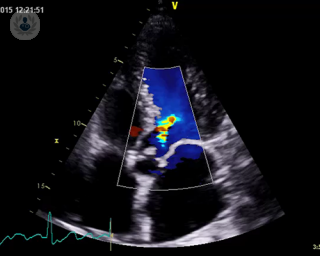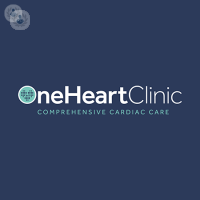What is an echocardiogram?
An echocardiogram is a non-invasive, painless ultrasound scan carried out to create an image of the heart. The exam uses ultrasound waves to view the structure and examine the functionality of the heart, including the chambers, valves, cardiac muscle and adjoining blood vessels.

What does an echocardiogram involve?
An echocardiogram is a non-invasive diagnostic tool that allows the doctor to examine the chambers of the heart and connecting blood vessels, providing useful information on your heart’s general state of health and on any potential cardiopathies.
It usually lasts 10-15 minutes, during which you’ll need to be very still. You will have to take your shirt off and lie down on a flat bed. A special gel will be applied on your skin and then some electrodes will be placed on your chest. A probe or transducer will be then placed on your chest and, thanks to the ultrasound waves the probe emits, the doctor will have a clear picture of your heart and surrounding structures.
What is an echocardiogram for?
An echocardiogram is done to get more information about your heart’s pumping strength, the condition of the valves and the blood flow to the heart’s cavities. It can be carried out in several different ways:
- Transthoracic echocardiogram – the transducer is placed on your chest, emitting ultrasound waves which will give a real time picture of your heart
- Transesophageal echocardiogram – it is done by endoscopy and it can identify conditions that are otherwise hard to diagnose, such as complex valvular defects, rare congenital malformations or conditions of the thoracic aorta
- Three-dimensional echocardiography – enables detailed anatomical assessment of the heart
You may require an echocardiogram if:
- You’ve had a heart attack
- You suffer from heart failure
- Your heart valves are damaged
- You’ve had an artificial heart valve implanted
- You were the recipient of a heart transplant
What does it feel like during the procedure?
You won’t feel any pain or discomfort as the procedure is completely painless and safe.
11-13-2012 07-28-2023Echocardiogram
Dr Alessandro Giardini - Paediatric cardiology
Created on: 11-13-2012
Updated on: 07-28-2023
Edited by: Sophie Kennedy
What is an echocardiogram?
An echocardiogram is a non-invasive, painless ultrasound scan carried out to create an image of the heart. The exam uses ultrasound waves to view the structure and examine the functionality of the heart, including the chambers, valves, cardiac muscle and adjoining blood vessels.

What does an echocardiogram involve?
An echocardiogram is a non-invasive diagnostic tool that allows the doctor to examine the chambers of the heart and connecting blood vessels, providing useful information on your heart’s general state of health and on any potential cardiopathies.
It usually lasts 10-15 minutes, during which you’ll need to be very still. You will have to take your shirt off and lie down on a flat bed. A special gel will be applied on your skin and then some electrodes will be placed on your chest. A probe or transducer will be then placed on your chest and, thanks to the ultrasound waves the probe emits, the doctor will have a clear picture of your heart and surrounding structures.
What is an echocardiogram for?
An echocardiogram is done to get more information about your heart’s pumping strength, the condition of the valves and the blood flow to the heart’s cavities. It can be carried out in several different ways:
- Transthoracic echocardiogram – the transducer is placed on your chest, emitting ultrasound waves which will give a real time picture of your heart
- Transesophageal echocardiogram – it is done by endoscopy and it can identify conditions that are otherwise hard to diagnose, such as complex valvular defects, rare congenital malformations or conditions of the thoracic aorta
- Three-dimensional echocardiography – enables detailed anatomical assessment of the heart
You may require an echocardiogram if:
- You’ve had a heart attack
- You suffer from heart failure
- Your heart valves are damaged
- You’ve had an artificial heart valve implanted
- You were the recipient of a heart transplant
What does it feel like during the procedure?
You won’t feel any pain or discomfort as the procedure is completely painless and safe.


Echocardiogram – Part 1: Why do I have to have an echocardiogram?
By Dr Allan Harkness
2025-01-15
The heart is one of the strongest muscles in the body, never tiring as it beats over 3 billion times during our lives to pump blood around the body. However, as with all parts of your body, things can go wrong. When this happens, one test that can help your doctor identify the problem is an echocardiogram. Dr Allan Harkness explains why echocardiograms are done. See more


What are the different kinds of non-invasive cardiac imaging tests?
By Dr Yousef Daryani
2025-01-15
You may have been told by your doctor that you need cardiac imaging to check for heart disease, or you may have symptoms of heart disease and want to be checked by a specialist. With the help of leading consultant cardiologist, Dr Yousef Daryani talks through the different procedures, and what to expect. See more


Exercise stress echocardiogram: when is it necessary?
By Dr Sothinathan (Nathan) Gurunathan
2025-01-15
Exercise is the key to a healthy heart, body and life. However, if a person is suffering from heart or chest problems, exercise can put further strain on the heart. An exercise stress echocardiogram is one method used to assess the heart. Renowned consultant cardiologist Dr Sothinathan (Nathan) Gurunathan is here to explain more about the test, including when it is required and how it is performed. See more


Echocardiogram – Part 3: Types of heart scan
By Dr Allan Harkness
2025-01-15
How does a doctor look inside your chest at your heart? How can a cardiologist check that all the chambers, blood vessels and valves are working properly? How are heart problems found? Top cardiologist Dr Allan Harkness concludes his series on echocardiograms with this guide to the different scans used to monitor heart health. See more
Experts in Echocardiogram
-
Dr Rajan Sharma
CardiologyExpert in:
- Echocardiogram
- Coronary heart disease
- Valvular heart disease
- Heart failure
- Hypertension (high blood pressure)
- Palpitations
-
Mr Masood Khan
CardiologyExpert in:
- Valvular heart disease
- Echocardiogram
- Chest pain
- Hypertension (high blood pressure)
- Heart failure
- Pacemaker
-
Professor Sanjay Sharma
CardiologyExpert in:
- Sports cardiology
- Dilated cardiomyopathy
- Sudden death
- Hereditary diseases
- Echocardiogram
- Heart failure
-
Dr Andrew Deaner
CardiologyExpert in:
- Cardiovascular disease
- Coronary angioplasty
- Echocardiogram
- Pacemaker
- Palpitations
- Heart failure
-
Dr Alessandro Giardini
Paediatric cardiologyExpert in:
- Chest pain
- Heart murmur
- Palpitations
- Syncope
- Echocardiogram
- Congenital heart disease
- See all

The Park Hospital - part of Circle Health Group
The Park Hospital - part of Circle Health Group
Sherwood Lodge Drive, Burntstump Country Park, Arnold, Nottinghamshire NG5 8RX
No existe teléfono en el centro.
By using the telephone number provided by TOP DOCTORS, you automatically agree to let us use your phone number for statistical and commercial purposes. For further information, read our Privacy Policy
Top Doctors

One Heart Clinic Marylebone
One Heart Clinic Marylebone
10-11 Bulstrode Pl, London W1U 2HX
No existe teléfono en el centro.
By using the telephone number provided by TOP DOCTORS, you automatically agree to let us use your phone number for statistical and commercial purposes. For further information, read our Privacy Policy
Top Doctors

The Saxon Clinic - part of Circle Health Group
The Saxon Clinic - part of Circle Health Group
V7 Saxon St, Coffee Hall, Milton Keynes MK6 5LR
No existe teléfono en el centro.
By using the telephone number provided by TOP DOCTORS, you automatically agree to let us use your phone number for statistical and commercial purposes. For further information, read our Privacy Policy
Top Doctors
-
The Park Hospital - part of Circle Health Group
Sherwood Lodge Drive, Burntstump Country Park, Arnold, Nottinghamshire NG5 8RX, ArnoldExpert in:
- General Surgery
- Maxillofacial Surgery
- Oral surgery
- Plastic surgery, reconstructive and aesthetics
- Obstetrics and Gynaecology
- Podiatry
-
One Heart Clinic Marylebone
10-11 Bulstrode Pl, London W1U 2HX, Central LondonExpert in:
- Cardiology
- Preventive cardiology
- Chest pain
- Breathlessness
- Palpitations
- Cardiovascular disease
-
The Saxon Clinic - part of Circle Health Group
V7 Saxon St, Coffee Hall, Milton Keynes MK6 5LR, Milton KeynesExpert in:
- General Surgery
- Orthopaedic surgery
- Gastroenterology
- Obstetrics and Gynaecology
- Paediatrics
- Urology
- See all
- Most viewed diseases, medical tests, and treatments
- Narcolepsy
- Snoring
- Polysomnography (sleep study)
- Alzheimer's disease
- Chronic headache
- Electrophysiology study
- Autoimmune diseases
- Joint pain
- Nutrition
- Genetic testing







